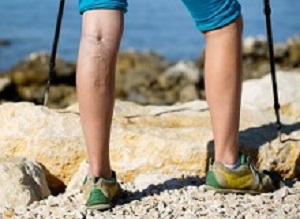 People with deep-vein thrombosis (DVT) can substantially cut their risk of potentially debilitating complications by starting adequate compression therapy in the first twenty-four hours of DVT therapy (known as the acute phase of treatment), suggests a study.
People with deep-vein thrombosis (DVT) can substantially cut their risk of potentially debilitating complications by starting adequate compression therapy in the first twenty-four hours of DVT therapy (known as the acute phase of treatment), suggests a study.
DVT occurs when a blood clot forms in a deep vein, commonly in the legs. DVT affects as many as 900,000 people in the US, and the condition carries a high risk of recurrence, death, or chronic debilitating symptoms such as pain and swelling.
The largest study to track outcomes from compression therapy in the acute phase of DVT to date, this research examined if immediate compression therapy could prevent residual vein occlusion and post thrombotic syndrome. Residual vein occlusion – when clots persist in veins with or without symptoms – is thought to be a contributing factor in the development of post thrombotic syndrome, a collection of persistent and often debilitating symptoms that can greatly diminish a person's quality of life, including pain, swelling, and discoloration and scaling in the affected leg.
Researchers prospectively studied nearly 600 DVT patients in the Netherlands who received compression therapy that began within 24 hours of diagnosis compared to patients that started compression therapy at a later point in time. Compression therapy was randomly administered using multi-layered bandaging or compression hosiery until oedema were reabsorbed, at which time all patients wore fitted compression stockings. In addition to compression, patients also received anticoagulants.
Patients who received immediate compression therapy were 20% less likely to develop residual vein occlusion and 8% less likely to suffer post thrombotic syndrome compared with those who did not receive immediate compression.
"We found little reason for those treating DVT not to use compression therapy as a prevention measure against future complications," said senior study author Dr Arina J ten Cate-Hoek of Maastricht University in the Netherlands.
Compression therapy was not associated with any adverse side effects. Patients with a blood clot lower in the leg appeared to benefit from compression to a greater extent than those with a blood clot higher in the leg, a result that is consistent with previous studies, according to researchers.
Patients with DVT are typically treated with medications to dissolve the clot and blood thinners to prevent the formation of new ones.
"Although the use of compression stockings after DVT is routine across much of Europe, it is less common in the US, where guidelines emphasise compression primarily for patients who complain of ongoing symptoms," said ten Cate-Hoek.
According to ten Cate-Hoek, compression therapy is thought to improve blood flow by reducing the diameter of veins so that blood is pushed through them more forcefully, helping to clear clot material.
"I think we can infer from our findings that this improved blood flow certainly helps prevent complications like residual vein occlusion and post thrombotic syndrome after DVT," she said. "Given these outcomes, and that compression stockings are fairly easy to self-administer, relatively inexpensive, and minimally intrusive, compression therapy offers a clear benefit for all patients with DVT."
Abstract
Thus far the association between residual vein occlusion and immediate compression therapy and post thrombotic syndrome is undetermined. Therefore, we investigated whether compression therapy immediately after diagnosis of deep vein thrombosis affects the occurrence of residual vein obstruction, (RVO) and whether the presence of RVO is associated with post thrombotic syndrome and recurrent venous thromboembolism. In a pre-specified sub study within the IDEAL DVT trial, 592 adult patients from 10 academic and non-academic centers across the Netherlands, with objectively confirmed proximal deep vein thrombosis of the leg, received no compression or acute compression within 24 hours of diagnosis of deep vein thrombosis with either multi-layer bandaging or compression hosiery (pressure 35mmHg). Presence of RVO and recurrent venous thromboembolism was confirmed with compression ultrasonography, incidence of post thrombotic syndrome as a Villalta score of >5 at 6 and 24 months. The average time from diagnosis until assessment of RVO was 5.3 (SD 1.9) months. A significantly lower percentage of patients who did receive compression therapy immediately after deep vein thrombosis had RVO, (46.3% versus 66.7%; OR 0.46 95% CI 0.27 to 0.80; p=0.005). Post thrombotic syndrome was less prevalent in patients without RVO (46.0 % versus. 54.0%; OR 0.65 95%CI 0.46 to 0.92; p=0.013). Recurrent venous thrombosis showed no significant association with RVO. Immediate compression should therefore be offered to all patients with acute deep venous thrombosis of the leg irrespective of severity of complaints.
Authors
Elham E Amin, Ingrid M Bistervels, Karina Meijer, Lidwine W Tick, Saskia Middeldorp, Guy Mostard, Marlène van de Poel, Erik H Serné, Hans M Otten, Edith M Klappe, Manuela A Joore, Hugo ten Cate, Marije ten Wolde, Arina J Ten Cate-Hoek
[link url="http://www.hematology.org/Newsroom/Press-Releases/2018/8958.aspx"]American Society of Haematology material[/link]
[link url="http://www.bloodjournal.org/content/early/2018/09/19/blood-2018-03-836783?sso-checked=true"]Blood abstract[/link]
